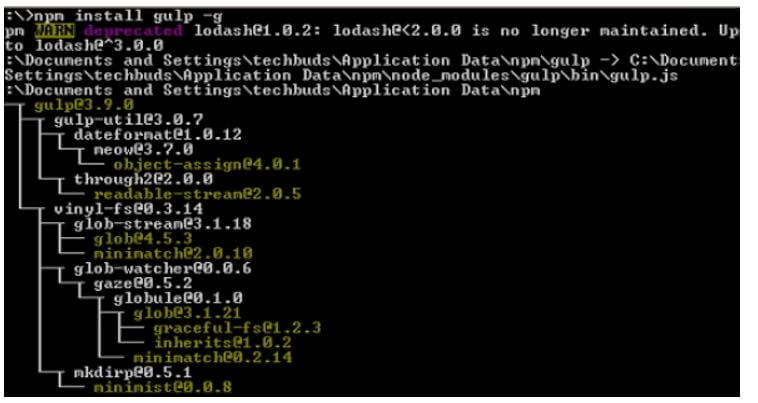Updated February 17, 2023
Introduction to Gulp serve
We know that Gulp is used to automate web tasks of developers; it provides different kinds of features to the developer during automation. Usually, the serve command offers another type of support to the developer to make easy development as per their requirement as; with the help of gulp serve, we can connect the server by using a static method; sometimes, a developer needs to reload web pages after the changes at that time we can also use serve. On the other hand, if the browser does not support WebSockets, then we can use the server mechanism to continue execution.
What is Gulp Serve?
The serve command permits you to serve either code from the ./investigate/serve organizer OR a singular bundle for testing in the program. The document will continuously be filled in as https://localhost:8080/Gulp/Demo/.js so you can make a static page in your occupant for simple testing of an assortment of situations. Note that this document will be hailed as dangerous in many programs, so you should trust it for it to execute on the page. Whenever a document is gotten, the present status is worked out to the file system, the way is refreshed to address the new area of the result record, and then, at that point, that scrape goes on down the pipeline. By and large, a site or a JavaScript application contains a few JavaScript documents. Moreover, the program should get those records from the server to stack the page. Downloading more records takes additional time as the program needs to send more HTTP demands.
We attempt to convey the ideal experience whenever we make sites. This incorporates having our website pages show quickly. Some time ago, this implied having every one of our styles in one CSS document. All Gulp setup goes in a record called gulpfile.js, situated at the foundation of the undertaking. The example for composing assignments is that you first burden a module you will utilize and characterize a project that depends on that module afterward. Gulp is module-driven; you want to know which module to use to achieve something. Usually, a solitary module has a solitary reason, and all the modules are customary JavaScript.
Usage Gulp serve
Let’s see the usage of services in a gulp as follows:
Code:
var gulps = require('gulp');
var serves = require('gulp-serve');
gulp.task('serves', serve('public'));
gulp.task('serve-build', serves(['public', 'build']));
gulp.task('serve-prod', servess({
root: ['public', 'build'],
port: 30,
middleware: function(v1, v2) {
}
}));Let’s see how we can use HTTPS with built-in keys as follows:
Code:
var gulps = require('gulp');
var serves = require('gulp-serve');
gulp.task('serves', serve('public'));
gulp.task('serve-build', serves(['public', 'build']));
gulp.task('serve-prod', servess({
root: ['public', 'build'],
port: 320,
https: true,
middleware: function(v1, v2) {
}
}));We add a true HTTPS key; here, we can also provide the self-generated key and certificate per our requirement.
Code:
var gulps = require('gulp');
var serves = require('gulp-serve');
gulp.task('serves', serve('public'));
gulp.task('serve-build', serves(['public', 'build']));
gulp.task('serve-prod', servess({
root: ['public', 'build'],
port: 30,
http:{
key: ‘Gulp/Demo/to/certificate.key’,
certificate: ‘Gulp/Demo/to/certificate.pem’
}
middleware: function(v1, v2) {
}
}));While running the command without boundaries, you will produce a bundle with the section found on the tsconfig.json record in ./investigate/serve. Of course, this will utilize serve.ts. This permits you to compose any code you need to test to handily run it in the program, with all changes being watched and setting off a remake. On the off chance that, instead, you need to test how a specific bundle will function in the program, you can serve that bundle. For this situation, you don’t have to indicate the conditions and determine whether different bundles will toss a blunder. Bundles will be infused into the worldwide namespace on a variable named sample.
How to Install Gulp serve?
Let’s see how we can install servers as follows:
First, we need to confirm all setup and installation of gulp with the help of the following command.
Code:
node -vExplanation:
- Using the above command, we can see the installed version of Node.js; after execution, we can see the result in the following command.
Output:
In the command line prompt, enter the accompanying command to show the variant of npm (Node.js bundle chief), which is utilized to introduce modules. It will show the introduced Node.js form with the help of the below command.
Code:
npm -vExplanation:
- After executing the above command, we can see the currently installed version of npm on our machine, as shown in the screenshot below.
Output:
We successfully installed Node.js; now, we need to install the gulp using the below command.
Code:
npm install gulp -gExplanation:
- In the above command, we use g for a flag that ensures gulp is globally available for all projects.
- After entering the above command, we get the following screen, as shown in the below screenshot.
Output:
For verification of gulp, we need to run the below command as follows:
Code:
gulp –vExplanation:
- After executing the above command, we get the currently installed version of a gulp, as shown in the screenshot below.
Output:
Now we can install the service with the help of the following command as follows.
Code:
npm i --save-dev gulp-serveExample of Gulp serve
Given below is the example of Gulp serve:
First, we must create a .js file and add the following code.
Code:
gulp.task('sampleserve', function() {
gulp.src('Gulp/Demo/public')
.pipe(server({
livereload: true,
open: true,
port: 8000
}));
});Explanation:
- In the above example, first, we need to install all required packages as below.
Code:
var gulps = require('gulp);
var servers = require('gulp-webserver');Now we need to run the above code using the gulp command; the result of the above implementation can be seen in the screenshot below.
Output:
Conclusion
With the help of the above article, we saw about the Gulp serve. From this article, we learned basic things about the Gulp serve and saw the integration of the Gulp help and how we use it in the Gulp serve.
Recommended Articles
This is a guide to Gulp serve. Here we discuss the introduction, usage, and how to install gulp serve. And examples, respectively. You may also have a look at the following articles to learn more –







